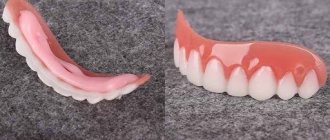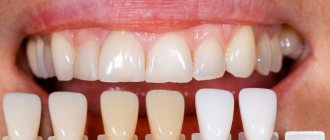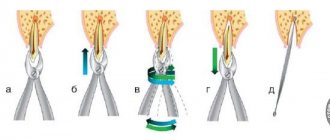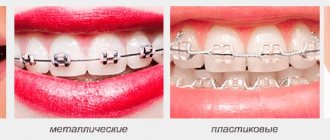Clear and understandable instructions in Russian Perfect Smile Veneers will help everyone who wants to achieve a truly Hollywood smile. But what kind of wonderful invention is hidden behind the long English name? And can removable veneers be a worthy replacement for permanent structures? Numerous user reviews say yes, it can. But only if you purchase a quality product and follow all recommendations for use. The instructions provided for them will help you learn how to use removable veneers correctly, as well as a training video on how to use Perfect Smile Veneers.
Purpose of veneers
Veneers are thin overlays on teeth, their thickness does not exceed 0.5 mm. They are made from a special material - composite or medical porcelain. The material does not disturb the natural acid-base balance in the oral cavity and is biologically compatible with the mucous membrane.
Removable veneers solve many problems with smile aesthetics:
- create the impression of an even row of teeth;
- give the impression of snow-white enamel.
Even if you have money, it is not always possible to achieve snow-white enamel. A person with a yellowish natural bone color will never have a snow-white smile, even modern whitening products will not help. The structural features of the enamel (too thin layer) are also an obstacle to mechanical teeth whitening. Therefore, removable veneers are a solution to the problem of smile aesthetics without complex dental procedures.
Installation recommendations:
- congenital yellowness of enamel;
- cosmetic defects of the dentition;
- yellowness of the enamel due to consumption of coffee, tea, cigarettes;
- enamel fluorosis (white or dark spots);
- pathology of the enamel coating due to frequent bleaching;
- slight curvature of teeth that cannot be corrected;
- large gaps between teeth;
- discoloration of fillings on the front teeth;
- exposure of roots.
Installation ban:
- bruxism;
- malocclusion;
- presence of bad habits (smoking);
- the habit of putting objects into the mouth (pens, pencils, fingers);
- multiple fillings on the front teeth;
- gum problems.
Bruxism is not a categorical prohibition on installing veneers. Grinding can be eliminated with the help of special mouth guards that are worn before bed.
Why is malocclusion an obstacle to installing veneers? Because the material will quickly fail and wear off. With an incorrect bite, the chewing load is distributed unevenly, which negatively affects the condition of the teeth and premature wear of the enamel.
Flaws
- They require careful treatment and careful care;
- some types require preliminary grinding of the enamel;
- are much more expensive than regular crowns;
- do not eliminate malocclusion;
- do not strengthen teeth.
When installing veneers, you should forget about seeds and other solid foods, as they can damage them.
Grinding of the enamel layer is the biggest disadvantage of overlay veneers. If the pain threshold is exceeded, the patient may experience constant discomfort even after the plates are installed. The enamel layer is not renewed, so after removing the onlays it is necessary to carry out restoration.
How I choose the color and shape of veneers
To determine the color, the doctor has a modern scale with ceramic veneers of various colors, it is called Vita 3d master
. It uses the most common colors of both ordinary teeth and the color palette to create veneers. It is very easy to apply the elements of the color scale to the patient’s teeth in order to understand which color of future veneers is most suitable and appealing to the patient.
Ideally, future veneers should be similar in color to the whites of the eyes. It’s like a combination of the color of a handbag and shoes: together with the patient, as if in a showroom of branded clothing, we look at various combinations of photographs of veneers and natural teeth, including paying attention to the selection of the desired shape. But the truly appropriate shape of veneers is determined by the technician in the laboratory, taking into account the individual characteristics of the person and his face, including gender, age, race and skin color, as well as focusing on the anatomical features of the patient’s face.
Can the patient see his future smile before veneers are installed?
Yes, of course he sees it, and as many as 3 times:
sees a mock-up of veneers for the first time- for the second time
at the wax-up stage, - for the third time
during a test installation directly in the mouth. As I said earlier, on the third visit the patient sees real ceramic veneers in the oral cavity, which are not yet fixed and can be easily removed.
And let me remind you that between the second and third visits to my dental office, the patient wears temporary veneers. The patient will have time to get used to it, relax, and tune in to the ceremonial moment of installing new teeth, since temporary veneers are a simplified prototype of future veneers; they are 90% close in shape to future veneers. Permanent veneers, to the delight of the patient, will be even smoother and more natural than temporary veneers.
Four advantages of installing veneers from me, Sergei Samsakov:
- I have been installing veneers for over 9 years
. - I have produced and recorded more than 150 works
. - My dental technician has great skill, as he worked in Germany as a dental technician for more than 10 years
, which allows our creative tandem to create truly beautiful and absolutely natural in color and shape “nature-like” teeth - If we talk about the veneers I installed in quantitative terms, then more than 3,000 teeth
have gained beauty.
How long does it take to install turnkey veneers?
The entire process from the first consultation to the installation of veneers, provided that the patient immediately agreed to the procedure, takes exactly 9 days. It is impossible to perform a high-quality turnkey installation of veneers faster in time, as the quality may suffer. And, on the other hand, it is undesirable to delay the installation of veneers, since if the period is longer, the ground teeth will remain longer than necessary under temporary veneers. The ideal time to install turnkey veneers is instantly, on the first day, but this is impossible. And more than 9-10 days, as I already said, is already a long time. After all, teeth are not 100% perfectly protected under temporary veneers. This factor must be taken into account and not hidden from the patient, but, in general, after a period of 9 days, the patient’s teeth remain in maximum protection. I can guarantee this to the patient, of course, if all my recommendations are followed.
How long does it take to install veneers?
I install veneers on a patient in 3.5-4 hours, if we are talking about the total installation of 20 veneers. And 2-2.5 hours, if we are talking about installing 10 veneers.
What procedures should a patient undergo before installing veneers?
Does the patient need sanitation and professional hygiene before installing veneers? Professional hygiene is, of course, important. But first of all, it is necessary to do a computed tomography (CT) to exclude pathologies, on which you can see:
- inflammatory processes,
- hidden carious processes,
- cracks on the roots of teeth,
- various structures inside the teeth.
A CT scan is needed so that all the nuances can be immediately discussed with the patient. And, before installing veneers, professional oral hygiene is mandatory.
If the teeth on which veneers are supposed to be installed require endodontic treatment, then it must be carried out.
Also, patients should pay special attention to this fact; if there are few chewing teeth in the patient’s mouth, then an implantation operation is first performed to restore chewing efficiency so that future veneers do not experience excessive stress and crack. Otherwise, excess chewing load will fall on the newly installed veneers, which will quickly lead to wear and breakage.
Varieties
Onlays can be made of composite material or medical porcelain and zirconium. Porcelain products are more durable, but more expensive. Composite structures will last from three to five years, then they should be replaced with new ones. The advantages of composite veneers include price and ease of removal/installation. Componeers (composite plates) require more careful care and regular visits to the dentist to coat the surface with a special varnish.
The most reliable are zirconium linings; they can last more than twenty years. However, they do not look natural; this is noticeable to the naked eye. The artificiality of zirconium overlays is explained by the lack of light conductivity. Another disadvantage is the need for strong grinding of the enamel before installing them.
However, the biggest disadvantage of installing overlays made of any material is the loss of part of the enamel layer.
Lumineers
These overlays are called Hollywood and differ from ordinary veneers in their thinness. They are made from transparent porcelain and attached using a special adhesive.
Lumineers are highly durable and can last up to twenty years with proper care. Do not stain when eaten. However, Lumineers are not suitable for everyone. Lumineers are so transparent that they cannot mask stains or yellowness of the enamel layer.
There is another significant drawback of lumineers - when removing the plates, the enamel coating is inevitably destroyed. This is due to the peculiarity of the cementing composition on which the linings are attached: it is too strong.
Removable veneers perfect smile
This prosthesis imitates the gums and upper teeth. Used in emergency cases when a beautiful smile is needed. This is an invention of American orthodontists. The prosthesis provides a snow-white smile without preliminary grinding of the enamel and a visit to the dentist’s office.
How to use removable perfect smile veneers? It's very easy to do. Before the first fitting, the prosthesis should be placed in a glass of boiling water for several minutes so that the material becomes pliable. Then the denture is removed and applied to the upper teeth, holding it with your hand for 1-2 minutes. During this time, the material of the product will take its shape and remember its location. For subsequent uses, do not place the prosthesis in boiling water.
How often can you wear a perfect smile? The prosthesis is worn any time a charming smile is needed. How long can I wear a prosthesis? You can wear your perfect smile all day long, but before going to bed you need to remove it and wash it. Wash the denture with plain water and periodically clean it with mouthwash.
Ultraneers
Ultraneers are made from pressed ceramic chips. The advantages of onlays include quick adaptation, since the patient practically does not feel the foreign body in the mouth. The products look natural and are indistinguishable from real teeth. Lumineers are manufactured in the USA, so the cost of installation is always very high. Ultraneers are three times cheaper, since they are produced in Russia.
However, installation of ultraneers sometimes requires grinding of the enamel. The quality of ultraneers is inferior to lumineers in many respects, but they are cheaper. Ultraneers are also an alternative to aggressive whitening, as they protect the enamel from thinning.
Ultraneers are installed in two visits to the orthodontist’s office: during the first visit, an impression of the jaw is made, and on the second, onlays are installed. Ultraneers are easily removable and can be replaced with ceramic or zirconium veneers.
Design and composition of Perfect Smile Veneers
The Perfect Smile Veneers kit includes a special two-piece dental plate made from high quality hypoallergenic materials.
The part simulating gums is made of silicone. This material is pleasant to the touch and ensures reliable fixation of the product in the mouth. The other part of the onlays, which imitate teeth, is made of flexible plastic - a combination of polypropylene and nylon. These materials are characterized by high strength and resistance to external factors: temperature, dyes, etc. In addition, this material is recognized as very durable, while being ultra-thin. This allows the plates to fit tightly and securely to the teeth without causing discomfort. For your information. The main bonus of purchasing the described product is the instructions offered for Perfect Smile Veneers in Russian. If you don’t have the opportunity or desire to delve into the essence of what is written by reading, you can use the option of familiarizing yourself with the instructions for use by watching the training video below.
Which material to choose
Which overlays are preferable and what to choose to improve the aesthetics of your smile? When choosing a material, you should consider some factors:
- naturalness when smiling;
- for minor cosmetic imperfections, you can safely choose lumineers;
- For the correction of two or three teeth, overlay plates made of composite materials are quite suitable.
The most expensive ones are zirconium plates and lumineers. Zirconium veneers are the leaders in terms of reliability and strength, while lumineers are the leaders in terms of aesthetics and beauty. The most short-lived ones are composite linings (sometimes they lose their properties after 3 years).
Front Row Correction
The aesthetics of a smile is the main requirement for overlay plates. For large enamel defects or chips, the best solution to camouflage the front teeth is ceramics (porcelain). Ceramic overlays look as natural as possible, they are translucent and perfectly transmit light rays. With the help of ceramic overlays you can correct such significant defects as:
- large gaps;
- missing half of a tooth after injury;
- strong yellowness of the enamel;
- stains on enamel from cigarettes, strong tea/coffee;
- slight curvature of the dentition.
Ceramic veneers are expensive, but with good care they last a long time. If you don’t bite seeds or open beer caps on a bottle with your teeth, ceramic linings will last for more than ten years.
You can also restore your front teeth using composite onlays, but they will only last 4-5 years. They are several times cheaper than ceramic ones. Also, the composite begins to change its shade over time due to food.
Correction of chewing teeth
What onlays should be chosen to cover the chewing molars? Ceramic and composite veneers are the least suitable for these purposes. Zirconium ones are more reliable and durable; they will withstand any chewing loads. Zirconium plates are expensive, but justify the cost with a long service life.
Method of attaching veneers
There are two methods of installing veneers in orthodontics:
- straight;
- indirect.
The indirect method involves creating onlays based on a cast of the jaw. However, this technique is applied only to products made of ceramics and zirconium; no processing is required for composite materials. Before installation, the inner surface of the overlay plate is treated with a special adhesive. Next, the surface of the tooth is degreased. After this, the lubricant is washed off and the surface is dried. Next, the enamel is lubricated with an adhesive mass, and a plate is installed on the tooth. For more reliable fixation, the installed plate is treated with a light lamp.
While ceramic and zirconium veneers are made by a dental technician in a laboratory based on an impression of the jaw, composite veneers are formed directly on the patient’s tooth. To do this, the dentist first carries out an antiseptic treatment. Then the composite material is applied to the tooth in layers and dried with an LED lamp. The procedure takes a sufficient amount of time, but the patient immediately leaves the doctor’s office with a beautiful smile.
The direct method of installing veneers is optimal in the presence of large chips and cracks on the surface of the molars. It restores the tooth and restores its original shape. Even if more than half of a molar is missing, the direct method of installing veneers will help restore what was lost using composite material. The method is reminiscent of placing a light filling, which is also made of a composite material and dried with a lamp.
Is the composition used to attach veneers harmful to dental health? The composition of the adhesive composition includes fluorine and other microelements useful for enamel, so dental glue is completely safe.
Do your teeth hurt after grinding? Some patients are very sensitive to the removal of the enamel coating and may feel pain for several days in a row after turning. If the pain becomes unbearable, you should take a pain reliever. After a few days, the pain will go away. If the pain does not go away for a long time, you need to notify your dentist.
Features of installing veneers from different materials
There are several types of materials from which records are made. The installation process depends on them. Here's how veneers are placed on teeth:
- Ceramics . Apply in layers, each layer is secured with a special device. At the end of the treatment, the veneers are fired.
- Zirconium dioxide . Produced in a laboratory by a medical technician, a special machine is used to create ultra-precise thicknesses and impressions.
- Porcelain . The plates are slightly less accurate, but they are also cheaper than zirconium. Due to the specifics of the material, they are more fragile.
There are several features of the installation technology by which veneers are placed on teeth.
Installation steps
Ceramic and zirconium overlays are installed within 10-14 days. This involves making veneers from an impression by a dental technician. While the ceramic products are being prepared, temporary plastic onlays are installed on the patient. This is necessary to protect the ground teeth from thermal influences when eating and the psychological comfort of the patient.
First, the dentist examines the oral cavity and determines the presence of teeth damaged by caries. Only after this the doctor begins work on installing veneers.
The surface layer of enamel is ground under local anesthesia. This is necessary so that the onlay fits perfectly on the tooth and looks natural. If the enamel is not sharpened, the plates will look very large and unnatural.
After grinding, an impression is made of the molars that require correction. The impression is transferred to the dental technician, who forms onlays for each molar separately.
The doctor then places temporary plastic onlays on the ground teeth in anticipation of permanent veneers.
After a couple of weeks, the patient is fitted with ceramic/zirconium veneers or lumineers.
Price
The cost of dental veneers is not high compared to other methods of dental restoration and depends on the method used to make the onlay.
- With the direct manufacturing method, veneers will cost less than those made in the laboratory.
- Larger sizes are more expensive than smaller ones due to the larger amount of work involved.
- If you install more than two overlays at the same time, the cost will be lower than if you install one plate at a time.
- For minor tooth defects, the cost of restoration will not be so high.
The final cost includes:
- Dentist consultation.
- Dental treatment.
- Oral hygiene.
- Tooth preparation.
- Anesthesia.
- Computer modelling.
Not the least influence on price formation is the status of the dental clinic, the experience and qualifications of the doctor.
| Dental veneers | Prices (in rubles) |
| Composite veneer | From 3000 |
| Porcelain veneer | From 15000 |
| Zirconium based veneer | From 17000 |
Veneer care
Oral care remains the same - twice a day. However, the paste should not contain abrasive substances, and the brush should not be hard. If it is not possible to properly clean teeth in hard-to-reach places, it is necessary to regularly visit the dental office for professional cleaning.
Veneers are made of fragile materials (except zirconium), so they should be taken care of. You should not crack seeds, chew nuts, indulge in candy, or eat solid foods (raw carrots, apples). Ceramic can crack easily and can be expensive to replace. Therefore, after installing the pads, your diet should be reconsidered.
Nicotine is well absorbed into any surface, so smoking after installation of veneers is not recommended.
Gum disease can ruin all your efforts to achieve a beautiful smile. If your gums start to bleed, visit your dentist immediately. Bleeding, loose gums will not be able to hold teeth in their sockets and will cause unsteadiness and even loss. Therefore, paying attention to your gums is the key to health and a beautiful smile.
Bottom line
Perfect smile veneers are an imitation of the upper row of teeth along with the gums, thanks to which you can not be afraid to smile openly and joke. The perfect smile removable denture does not require a visit to the orthodontist or preliminary teeth grinding. To get a snow-white smile, you just need to put the denture on the upper jaw and hold it lightly until it takes the anatomical shape of your teeth. However, the perfect smile has a drawback: the lack of imitation of the lower jaw.
To correct small defects in the dentition, you can purchase lumineers: their installation does not require grinding of the enamel. If there are significant defects in the dentition, lumineers will not help, as they are made of completely transparent material. To correct large defects, ceramic onlays or plates made of composite material are required.
Sources used:
- The National Center for Biotechnology Information (USA)
- Proffitt U.R., Modern orthodontics (3rd edition), MEDpress-inform, 2015, 560 p.
- “Orthopedic treatment with fixed prostheses” (Rozenstiel S.F.)










